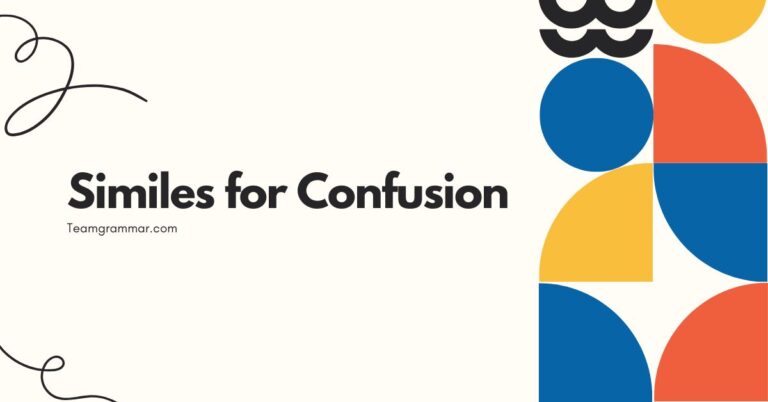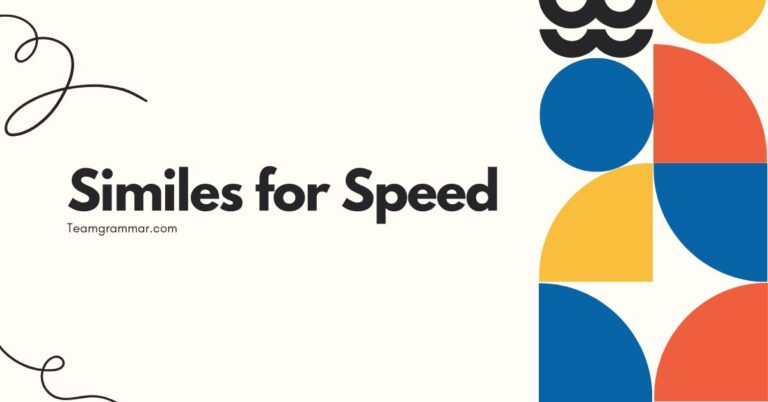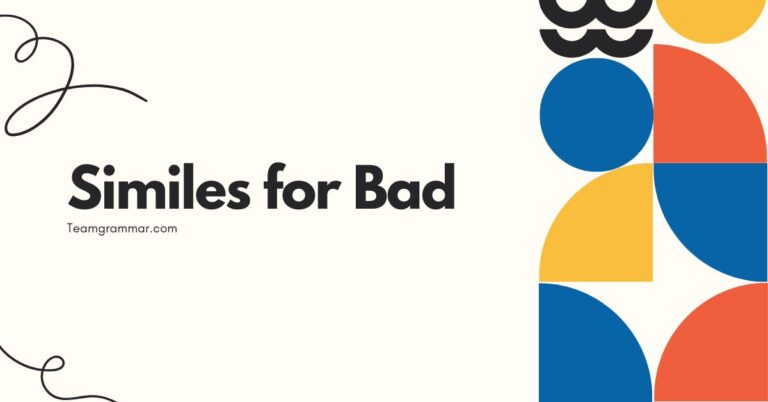37 Similes for Laughing: A Grammatical Guide to Hilarious Comparisons
Similes, those delightful figures of speech that compare two unlike things using “like” or “as,” are powerful tools for writers and speakers. When used cleverly, they can evoke vivid imagery and, most importantly, generate laughter.
Understanding how to craft effective and humorous similes can significantly enhance your comedic timing and writing. This article explores the nuances of similes specifically designed to elicit laughter, examining their structure, types, and usage.
Whether you’re a budding comedian, a creative writer, or simply someone who enjoys a good laugh, this guide will provide you with the knowledge and skills to craft side-splitting similes.
Table of Contents
- Introduction
- Definition of Similes
- Structural Breakdown of Humorous Similes
- Types of Laughing Similes
- Examples of Similes for Laughing
- Usage Rules for Humorous Similes
- Common Mistakes with Similes
- Practice Exercises
- Advanced Topics in Simile Creation
- Frequently Asked Questions (FAQ)
- Conclusion
Definition of Similes
A simile is a figure of speech that directly compares two different things using the words “like” or “as.” The purpose of a simile is to create a vivid image or highlight a particular quality by associating it with something familiar. In the context of humor, similes can be crafted to create unexpected or absurd comparisons, leading to laughter.
Similes are classified as figures of speech, specifically belonging to the category of figurative language. Their function is to enhance description, evoke emotion, and in this case, generate humor.
Similes are used in various contexts, from literature and poetry to everyday conversation and stand-up comedy. They are valuable tools for making writing more engaging and memorable.
When used effectively, a simile can transform a mundane description into something extraordinary and humorous. The key to a successful simile is the originality and aptness of the comparison.
Structural Breakdown of Humorous Similes
The basic structure of a simile involves two elements: thesubjectand theanalogue. The subject is the thing being described, and the analogue is the thing it is being compared to.
The comparison is explicitly stated using “like” or “as.” For humorous similes, the effectiveness often lies in the surprising or unexpected nature of the analogue. Here’s a breakdown:
- Subject: The thing being described (e.g., “His joke”)
- Comparison Word: “Like” or “as”
- Analogue: The thing being compared to, chosen for humorous effect (e.g., “a screen door in a hurricane”)
A humorous simile often works by creating a contrast between the subject and the analogue. The greater the contrast, the funnier the simile is likely to be.
For example, comparing someone’s clumsiness to a graceful ballet dancer would be ironic and humorous. The element of surprise is also crucial.
If the comparison is too obvious or predictable, it won’t generate laughter. The best humorous similes are those that make you think, “I never thought of it that way!”
Consider the following example: “His excuse was as flimsy as a house of cards in a wind tunnel.” Here, the subject is “his excuse,” and the analogue is “a house of cards in a wind tunnel.” The comparison uses “as,” and the humorous effect comes from the image of something inherently weak being placed in an environment that guarantees its destruction. The absurdity of this image is what makes the simile funny.
Types of Laughing Similes
Humorous similes can be categorized based on the type of humor they employ. Understanding these categories can help you craft more effective and targeted jokes.
Here are some common types:
Exaggerated Similes
Exaggerated similes, also known as hyperbole, create humor by overstating a particular quality or characteristic. The key is to make the exaggeration so extreme that it becomes absurd and funny.
These similes often use phrases like “as… as possible” or “more… than anything else.”
For instance, “He was as nervous as a long-tailed cat in a room full of rocking chairs” exaggerates the feeling of nervousness to a comical degree. The image of a cat constantly dodging rocking chairs is inherently funny.
Ironic Similes
Ironic similes create humor by contrasting what is expected with what is actually true. They often involve comparing something negative to something positive, or vice versa.
The irony lies in the incongruity of the comparison.
For example, “He was as graceful as a bull in a china shop” is ironic because bulls are known for their lack of grace, especially in delicate environments like china shops. The contrast between the expected gracefulness and the actual clumsiness is what makes the simile humorous.
Unexpected Similes
Unexpected similes work by comparing something to something completely unrelated or surprising. The humor comes from the shock of the unexpected comparison.
These similes often require a bit of creative thinking to come up with truly original and funny comparisons.
Consider the simile, “His singing voice was like a rusty lawnmower trying to start on a cold morning.” The comparison between a singing voice and a rusty lawnmower is unexpected and absurd, making it humorous.
Self-Deprecating Similes
Self-deprecating similes involve making fun of oneself by comparing oneself to something negative or undesirable. This type of humor can be very effective because it shows humility and makes the speaker more relatable.
For example, “I’m as useful as a screen door on a submarine” is a self-deprecating simile that highlights the speaker’s perceived uselessness in a humorous way. The image of a screen door underwater is inherently absurd and funny.
Absurdist Similes
Absurdist similes rely on illogical or nonsensical comparisons to create humor. They often defy logic and reason, resulting in a surreal and funny effect.
These similes are often used in surreal or absurdist comedy.
An example of an absurdist simile is, “The argument was as productive as teaching a goldfish to play the trumpet.” The comparison is absurd because goldfish are incapable of playing trumpets, making the argument seem equally futile and ridiculous.
Examples of Similes for Laughing
To further illustrate the different types of humorous similes, here are several examples categorized by the type of humor they employ. Each table provides a range of similes to inspire your own comedic creations.
These examples are designed to showcase the versatility and effectiveness of similes in generating laughter.
The following table provides examples of exaggerated similes, where the humor is derived from overstating a particular quality to an absurd degree. These similes often use phrases like “as… as possible” or “more… than anything else” to emphasize the exaggeration.
| Simile | Explanation |
|---|---|
| He was as hungry as a bear after hibernation. | Exaggerates extreme hunger. |
| She was as excited as a kid in a candy store. | Highlights overwhelming excitement. |
| The traffic was as slow as molasses in January. | Emphasizes extreme slowness. |
| He ran as fast as a cheetah on roller skates. | Combines speed with absurdity. |
| She was as stubborn as a mule trying to climb a greased pole. | Highlights extreme stubbornness with a ridiculous image. |
| The baby was as loud as a jet engine taking off. | Exaggerates the volume of the baby’s cries. |
| His ego was as big as Texas. | Overstates the size of his ego. |
| She was as surprised as a fish out of water. | Highlights extreme surprise. |
| The joke was as old as the hills. | Emphasizes the age of the joke. |
| He was as clueless as a newborn kitten in a library. | Highlights extreme cluelessness in an absurd setting. |
| She was as busy as a one-legged cat in a sandbox. | Highlights extreme busyness. |
| He was as red as a lobster after spending a day in the sun. | Emphasizes the intensity of the sunburn. |
| The line was as long as a CVS receipt. | Exaggerates the length of the line. |
| She was as tired as a sloth on caffeine withdrawal. | Highlights extreme tiredness. |
| He was as nervous as a vegan at a barbecue. | Emphasizes the nervousness in a humorous situation. |
| She was as happy as a clam at high tide. | Highlights extreme happiness. |
| He was as broke as a joke. | Emphasizes the lack of funds. |
| She was as quiet as a mouse tiptoeing through cotton. | Highlights extreme quietness. |
| He was as lost as a sock in the dryer. | Emphasizes the feeling of being lost. |
| She was as graceful as a baby giraffe learning to walk. | Highlights the lack of grace in a humorous way. |
| He was as organized as a hoarder’s closet. | Emphasizes the lack of organization. |
| She was as patient as a saint waiting in line at the DMV. | Highlights extreme patience. |
| He was as excited as a dog with two tails. | Highlights extreme excitment. |
The table below provides examples of ironic similes, where the humor is derived from contrasting what is expected with what is actually true. These similes often involve comparing something negative to something positive, or vice versa, to create a humorous effect.
| Simile | Explanation |
|---|---|
| He’s as sharp as a marble. | Ironic comparison of intelligence. |
| She’s as friendly as a rattlesnake. | Ironic comparison of friendliness. |
| His driving is as smooth as a gravel road. | Ironic comparison of driving skill. |
| The coffee was as warm as a snowman’s heart. | Ironic comparison of temperature. |
| He’s as reliable as a politician’s promise. | Ironic comparison of reliability. |
| Her singing voice is as soothing as nails on a chalkboard. | Ironic comparison of sound quality. |
| He’s as helpful as a chocolate teapot. | Ironic comparison of helpfulness. |
| The presentation was as clear as mud. | Ironic comparison of clarity. |
| He’s as subtle as a freight train. | Ironic comparison of subtlety. |
| Her cooking is as delightful as burnt toast. | Ironic comparison of culinary skill. |
| The customer service was as pleasant as a root canal. | Ironic comparison of customer service. |
| The weather is as predictable as a toddler’s mood swings. | Ironic comparison of predictability. |
| His jokes are as funny as a funeral. | Ironic comparison of humor. |
| The traffic is moving as quickly as a herd of turtles. | Ironic comparison of speed. |
| His dance moves are as fluid as a rusty robot. | Ironic comparison of fluidity. |
| The organization in his office is as neat as a tornado. | Ironic comparison of neatness. |
| His advice is as valuable as a coupon for a store that’s closed. | Ironic comparison of value. |
| The silence in the room was as comfortable as a porcupine in a balloon factory. | Ironic comparison of comfort. |
| His memory is as sharp as a butter knife. | Ironic comparison of memory. |
| The service here is as fast as a snail delivering mail. | Ironic comparison of speed. |
| He’s as approachable as a cactus. | Ironic comparison of approachability. |
| The Wi-Fi signal is as strong as a whisper in a hurricane. | Ironic comparison of strength. |
| His fashion sense is as stylish as a clown’s wardrobe. | Ironic comparison of style. |
The following table provides examples of unexpected similes, where the humor is derived from comparing something to something completely unrelated or surprising. These similes often require creative thinking to come up with truly original and funny comparisons.
| Simile | Explanation |
|---|---|
| His explanation was as clear as a penguin in a pizza parlor. | Unexpected and absurd comparison. |
| She sings like a walrus gargling with gravel. | Surprising and humorous auditory image. |
| The idea was as bright as a black hole. | Contradictory and funny comparison. |
| His dance moves were as smooth as sandpaper. | Unexpected and amusing comparison. |
| The car ride was as comfortable as sitting on a washing machine during spin cycle. | Surprising and uncomfortable comparison. |
| The meeting was as exciting as watching paint dry. | Unexpected and boring comparison. |
| His presentation was as captivating as a blank screen. | Surprising and uninteresting comparison. |
| The soup tasted like socks after a marathon. | Unexpected and unpleasant comparison. |
| His directions were as helpful as a map of Middle Earth. | Surprising and unhelpful comparison. |
| The party was as lively as a library at 3 AM. | Unexpected and dull comparison. |
| Her smile was as genuine as a plastic flower. | Surprising and artificial comparison. |
| His jokes are as fresh as a fossil. | Unexpected and stale comparison. |
| The conversation flowed like a broken faucet. | Surprising and awkward comparison. |
| His attempt at cooking was as successful as a cat trying to herd squirrels. | Unexpected and unsuccessful comparison. |
| The solution was as obvious as a unicorn in a business meeting. | Surprising and conspicuous comparison. |
| His fashion sense is as timeless as a disco ball. | Unexpected and dated comparison. |
| The project was as organized as a flock of pigeons fighting over a french fry. | Unexpected and chaotic comparison. |
| His attention span is as long as a fruit fly’s life. | Unexpected and short comparison. |
| The plot twist was as subtle as a marching band in a library. | Unexpected and conspicuous comparison. |
| His apology was as sincere as a telemarketer’s smile. | Unexpected and insincere comparison. |
| The challenge was as easy as parallel parking on Mars. | Unexpected and difficult comparison. |
| His understanding of the topic was as deep as a puddle in the desert. | Unexpected and shallow comparison. |
| The news was as welcome as a skunk at a garden party. | Unexpected and unwelcome comparison. |
Below is a table filled with self-deprecating similes, where the humor comes from making fun of oneself. These similes show humility and make the speaker more relatable.
| Simile | Explanation |
|---|---|
| I’m as graceful as a newborn giraffe. | Humorously admitting clumsiness. |
| I’m as organized as a hurricane. | Humorously admitting disorganization. |
| I’m as bright as a burnt-out bulb. | Humorously admitting lack of intelligence. |
| I’m as useful as a screen door on a submarine. | Humorously admitting uselessness. |
| I’m as smooth as sandpaper. | Humorously admitting lack of social grace. |
| I’m as coordinated as a newborn octopus. | Humorously admitting lack of coordination. |
| I’m as decisive as a leaf in the wind. | Humorously admitting indecisiveness. |
| I’m as patient as a toddler waiting for candy. | Humorously admitting impatience. |
| I’m as intimidating as a fluffy kitten. | Humorously admitting lack of intimidation. |
| I’m as punctual as a broken clock. | Humorously admitting tardiness. |
| I’m as quiet as a marching band. | Humorously admitting noisiness. |
| I’m as subtle as a foghorn. | Humorously admitting lack of subtlety. |
| I’m as helpful as a chocolate teapot. | Humorously admitting unhelpfulness. |
| I’m as athletic as a potato. | Humorously admitting lack of athleticism. |
| I’m as romantic as a spreadsheet. | Humorously admitting lack of romance. |
| I’m as flexible as a brick. | Humorously admitting inflexibility. |
| I’m as mysterious as an open book. | Humorously admitting lack of mystery. |
| I’m as observant as a goldfish. | Humorously admitting lack of awareness. |
| I’m as fashionable as a scarecrow. | Humorously admitting lack of style. |
| I’m as charismatic as a wet blanket. | Humorously admitting lack of charisma. |
| I’m as reliable as a weather forecast. | Humorously admitting unreliability. |
| I’m as popular as a tax audit. | Humorously admitting lack of popularity. |
| I’m as calm as a caffeinated squirrel. | Humorously admitting nervousness. |
This table showcases absurdist similes, where the humor is derived from illogical or nonsensical comparisons. These similes defy logic and reason, resulting in a surreal and funny effect.
| Simile | Explanation |
|---|---|
| The idea was as useful as a chocolate teapot on Mars. | Illogical and nonsensical. |
| The argument was as productive as teaching a goldfish to knit. | Absurd comparison. |
| The plan was as clear as a screen door on a submarine. | Illogical and nonsensical. |
| His singing voice was like a walrus tap-dancing on a xylophone. | Absurd auditory image. |
| The situation was as calm as a penguin in a pizza oven. | Illogical and nonsensical. |
| The project was as organized as a herd of cats playing chess. | Absurd comparison. |
| His apology was as sincere as a vegan selling steak. | Illogical and nonsensical. |
| The explanation was as helpful as a map of Narnia to a plumber. | Absurd comparison. |
| The party was as lively as a convention of mimes. | Illogical and nonsensical. |
| His dancing was as smooth as a caffeinated giraffe on roller skates. | Absurd auditory image. |
| The solution was as obvious as a purple elephant wearing polka dots. | Illogical and nonsensical. |
| The conversation was as engaging as watching paint dry on a banana. | Absurd comparison. |
| The weather was as predictable as a squirrel’s retirement plan. | Illogical and nonsensical. |
| His fashion sense was as timeless as a dinosaur wearing a tutu. | Absurd auditory image. |
| The meeting was as productive as a committee of clouds. | Illogical and nonsensical. |
| His cooking skills were as impressive as a goldfish reciting Shakespeare. | Absurd comparison. |
| The directions were as clear as a fortune cookie written in Klingon. | Illogical and nonsensical. |
| The Wi-Fi signal was as strong as a whisper in a library full of elephants. | Absurd auditory image. |
| The challenge was as easy as herding cats on a trampoline. | Illogical and nonsensical. |
| His patience was as endless as a rubber band in a black hole. | Absurd comparison. |
| The news was as welcome as a clown at a funeral. | Illogical and nonsensical. |
| Her singing was as beautiful as a kazoo solo in an opera. | Absurd auditory image. |
| His jokes were as funny as a penguin wearing a sombrero. | Illogical and nonsensical. |
Usage Rules for Humorous Similes
When crafting humorous similes, several rules and guidelines can help ensure their effectiveness. These rules cover aspects such as clarity, originality, and appropriateness.
Adhering to these guidelines can significantly enhance the humor and impact of your similes.
- Clarity: The comparison should be clear and easy to understand. The audience should be able to quickly grasp the connection between the subject and the analogue.
- Originality: Avoid clichés and overused comparisons. The more original and unexpected the simile, the funnier it will be.
- Appropriateness: Consider the context and audience. What might be funny in one situation could be offensive in another.
- Imagery: Use vivid and descriptive language to create a strong mental image. The more detailed the image, the funnier the simile will be.
- Brevity: Keep the simile concise and to the point. A long and drawn-out simile can lose its humor.
Exceptions to these rules may occur in certain contexts, such as absurdist comedy, where the humor comes from defying logic and reason. However, in most cases, following these guidelines will help you create effective and humorous similes.
Common Mistakes with Similes
Even experienced writers and speakers can make mistakes when using similes. Being aware of these common errors can help you avoid them and improve the quality of your writing.
Here are some frequent mistakes:
- Using clichés: Overused similes like “as busy as a bee” or “as strong as an ox” lack originality and can make your writing seem uninspired.
- Creating illogical comparisons: The comparison should make sense, even if it’s absurd. Comparing something to something completely unrelated without a clear connection can confuse the audience.
- Being too literal: Similes are meant to be figurative, not literal. Avoid comparisons that are too obvious or straightforward.
- Using incorrect grammar: Ensure that the simile is grammatically correct. Incorrect use of “like” or “as” can weaken the impact of the comparison.
- Overusing similes: Using too many similes in a short space can make your writing seem cluttered and distracting.
Here are some examples of common mistakes and how to correct them:
| Incorrect | Correct | Explanation |
|---|---|---|
| He was as busy as a bee. | He was as busy as a one-armed juggler at a circus. | The original simile is a cliché; the corrected version is more original. |
| She was as fast as a car. | She was as fast as a caffeinated cheetah on a skateboard. | The original simile is too literal; the corrected version is more figurative. |
| He is like strong. | He is as strong as an ox. | The original simile has incorrect grammar; the corrected version is grammatically correct. |
Practice Exercises
To test your understanding of humorous similes, here are some practice exercises. Try to create your own similes based on the prompts provided.
The answers are provided below for you to check your work.
Exercise 1: Fill in the Blanks
Complete the following similes with a humorous analogue:
| Question | Answer |
|---|---|
| 1. His excuse was as believable as ______________. | a politician’s promise |
| 2. She sings like ______________. | a cat being strangled |
| 3. The traffic was as slow as ______________. | a herd of turtles stampeding through peanut butter |
| 4. He is as sharp as ______________. | a bowling ball |
| 5. My cooking skills are as good as ______________. | a toddler performing brain surgery |
| 6. The presentation was as clear as ______________. | a snow globe in a blender |
| 7. The news was as welcome as ______________. | a shark at a swimming lesson |
| 8. His fashion sense is as timeless as ______________. | a mullet |
| 9. I’m as organized as ______________. | a tornado |
| 10. He’s as helpful as ______________. | a chocolate teapot |
Exercise 2: Create Your Own Similes
Create a humorous simile for each of the following subjects:
| Subject | Your Simile |
|---|---|
| 1. A bad haircut | Like a lawnmower attacked my head while I slept. |
| 2. A boring lecture | As exciting as watching paint dry on a rainy day. |
| 3. A crowded bus | Like sardines packed in a metal can on wheels. |
| 4. A stubborn person | As immovable as a mountain goat glued to a rock. |
| 5. A messy room | Like a bomb exploded in a thrift store. |
| 6. A slow computer | As fast as a snail on a treadmill. |
| 7. A complicated recipe | As clear as hieroglyphics to a modern reader. |
| 8. A terrible singer | Like a dying cat being forced to sing opera. |
| 9. An awkward silence | As comfortable as sitting on a cactus. |
| 10. A long meeting | As endless as a CVS receipt. |
Advanced Topics in Simile Creation
For advanced learners, there are several more complex aspects of simile creation to consider. These topics delve into the subtleties of language and humor, allowing you to craft even more sophisticated and effective similes.
- Subverting Expectations: Create humor by setting up an expectation and then subverting it with an unexpected comparison.
- Using Cultural References: Incorporate pop culture references or historical events to add depth and humor to your similes.
- Playing with Sound: Use alliteration, assonance, or other sound devices to enhance the rhythm and humor of your similes.
- Combining Similes with Other Figures of Speech: Combine similes with metaphors, personification, or other figures of speech to create more complex and layered effects.
- Tailoring Similes to Specific Audiences: Consider the knowledge, background, and sense of humor of your audience when crafting similes.
Mastering these advanced techniques can elevate your simile creation skills to a new level, allowing you to craft jokes that are both clever and hilarious.
Frequently Asked Questions (FAQ)
- What is the difference between a simile and a metaphor?
A simile compares two things using “like” or “as,” while a metaphor directly states that one thing is another. For example, “He is like a lion” (simile) vs. “He is a lion” (metaphor).
- Can a simile be too obvious?
Yes, if a simile is too obvious or cliché, it loses its impact and may not be funny. Originality is key to creating effective humorous similes.
- How can I make my similes more original?
Think outside the box and consider unexpected or unusual comparisons. Use vivid imagery and descriptive language to create a strong mental picture.
- Is it okay to use offensive similes?
It depends on the context and audience. Be mindful of the potential impact of your words and avoid similes that could be hurtful or offensive.
- How many similes should I use in a piece of writing?
Use similes sparingly to avoid overwhelming the reader. Too many similes can make your writing seem cluttered and distracting.
- Can similes be used in formal writing?
While similes are more common in creative writing, they can be used in formal writing to add emphasis or clarity, but should be used judiciously.
- What are some common simile clichés to avoid?
Avoid clichés like “as busy as a bee,” “as strong as an ox,” “as quiet as a mouse,” and “as blind as a bat.”
- How do I know if my simile is funny?
Test it out on a small group of people and see if they laugh. If not, try tweaking the comparison or coming up with something more unexpected.
- Are there any online resources for finding simile examples?
Yes, many websites and online dictionaries provide examples of similes. You can also find inspiration in literature, poetry, and comedy.
- Can a simile compare more than two things?
While it’s more common to compare
two things in a simile, it is possible to compare more than two, though it should be done carefully to maintain clarity and impact.
Conclusion
In conclusion, mastering the art of crafting humorous similes can significantly enhance your writing and comedic timing. By understanding the structure, types, and usage rules of similes, you can create jokes that are both clever and hilarious.
Remember to avoid common mistakes, practice regularly, and explore advanced techniques to elevate your simile creation skills. Whether you’re a writer, speaker, or simply someone who enjoys a good laugh, the ability to craft effective and humorous similes is a valuable asset.
So go forth and create similes that tickle the funny bone and bring joy to your audience!







